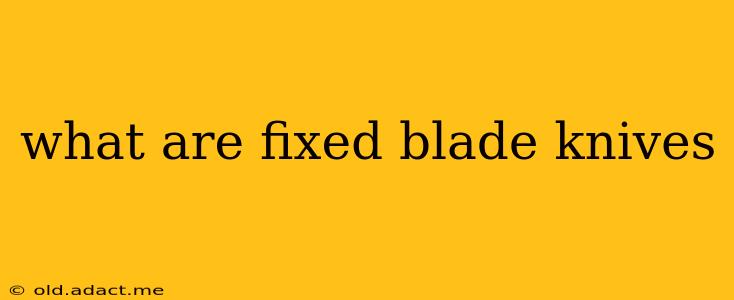Fixed blade knives are a timeless tool, prized for their strength, reliability, and versatility. Unlike folding knives, which have a blade that folds into the handle, fixed blade knives feature a blade that is permanently attached to the handle. This simple yet crucial design difference significantly impacts their performance, making them ideal for specific tasks and preferred by many enthusiasts. This guide will explore the world of fixed blade knives, answering common questions and highlighting their key features.
What Makes a Fixed Blade Knife Different?
The core difference lies in the blade's construction. The blade of a fixed blade knife is rigidly secured to the handle, typically through a full tang or a partial tang construction. This creates a much stronger and more robust tool compared to a folding knife. This strength translates to superior performance in demanding situations, making them excellent choices for heavy-duty tasks.
What Are the Advantages of Fixed Blade Knives?
Several advantages make fixed blade knives a top choice for many users:
- Strength and Durability: Their fixed blade construction provides exceptional strength and durability, making them ideal for demanding tasks like chopping, batoning, and heavy-duty cutting.
- Reliability: You don't have to worry about the blade locking mechanism failing during a crucial moment. The fixed blade offers consistent performance.
- Sharper Edges: Because the blade is fixed, it can be sharpened to a finer edge, resulting in cleaner, more precise cuts.
- Better Leverage: The rigid blade and handle connection provides greater leverage, allowing for more powerful cuts and easier penetration through tough materials.
What Are the Disadvantages of Fixed Blade Knives?
While fixed blade knives offer several advantages, there are some disadvantages to consider:
- Size and Weight: They tend to be larger and heavier than folding knives, making them less convenient for everyday carry.
- Safety Concerns: The always-exposed blade requires more careful handling to prevent accidental injuries.
- Storage: Because of their size, they require more careful storage to ensure safety and prevent damage.
What Are Fixed Blade Knives Used For?
Fixed blade knives' versatility makes them suitable for a wide range of applications:
- Hunting: Their strength and reliability make them essential tools for field dressing game.
- Camping and Hiking: They are invaluable for tasks like preparing food, building shelters, and general outdoor tasks.
- Survival: In survival situations, a robust fixed blade knife can be a lifesaver.
- Tactical and Military Applications: Many specialized fixed blade knives are designed for tactical and military use.
- Everyday Carry (EDC) - Some Models: While generally larger, some smaller fixed blades are popular for EDC use by those who prioritize durability and reliability over compactness.
What Types of Fixed Blade Knives Are There?
Fixed blade knives come in various designs, each suited to specific tasks. Some common types include:
- Bowies: Known for their large, clip-point blades, Bowies are iconic and powerful.
- Skinners: Designed for precise skinning and butchering tasks.
- Drop-Point Blades: Feature a smooth curve from the spine to the tip, providing excellent strength and versatility.
- Tanto Blades: Characterized by their distinctive, pointed tip and strong, flat grind.
How Do I Choose a Fixed Blade Knife?
Choosing the right fixed blade knife depends on your intended use. Consider these factors:
- Blade Material: Different materials offer varying levels of strength, durability, and edge retention.
- Handle Material: The handle should be comfortable, secure, and durable.
- Blade Length and Shape: The blade's length and shape should suit the intended tasks.
- Overall Size and Weight: Consider the knife's size and weight in relation to your intended use and carrying method.
What Materials Are Used in Fixed Blade Knives?
Fixed blade knives utilize a range of materials for their blades and handles:
- Blade Materials: Stainless steel (various grades), carbon steel, tool steel (e.g., D2, CPM S30V). Each offers a unique balance of strength, corrosion resistance, and edge retention.
- Handle Materials: Wood, Micarta, G10, bone, polymer, and even stabilized wood are commonly used, offering varying degrees of durability, grip, and aesthetics.
Are Fixed Blade Knives Legal?
Knife laws vary significantly depending on location. It's crucial to understand and comply with local and state laws regarding knife ownership and carry. Research your local regulations before purchasing or carrying a fixed blade knife.
This comprehensive guide offers a detailed overview of fixed blade knives. Remember to always handle knives safely and responsibly. Further research into specific knife types and brands can help you find the perfect fixed blade knife for your needs.
